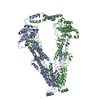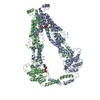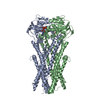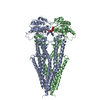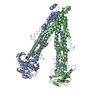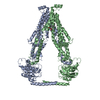+Search query
-Structure paper
| Title | Structural insights into substrate recognition and translocation of human peroxisomal ABC transporter ALDP. |
|---|---|
| Journal, issue, pages | Signal Transduct Target Ther, Vol. 8, Issue 1, Page 74, Year 2023 |
| Publish date | Feb 22, 2023 |
 Authors Authors | Chao Xiong / Li-Na Jia / Wei-Xi Xiong / Xin-Tong Wu / Liu-Lin Xiong / Ting-Hua Wang / Dong Zhou / Zhen Hong / Zheng Liu / Lin Tang /  |
| PubMed Abstract | Dysfunctions of ATP-binding cassette, subfamily D, member 1 (ABCD1) cause X-linked adrenoleukodystrophy, a rare neurodegenerative disease that affects all human tissues. Residing in the peroxisome ...Dysfunctions of ATP-binding cassette, subfamily D, member 1 (ABCD1) cause X-linked adrenoleukodystrophy, a rare neurodegenerative disease that affects all human tissues. Residing in the peroxisome membrane, ABCD1 plays a role in the translocation of very long-chain fatty acids for their β-oxidation. Here, the six cryo-electron microscopy structures of ABCD1 in four distinct conformational states were presented. In the transporter dimer, two transmembrane domains form the substrate translocation pathway, and two nucleotide-binding domains form the ATP-binding site that binds and hydrolyzes ATP. The ABCD1 structures provide a starting point for elucidating the substrate recognition and translocation mechanism of ABCD1. Each of the four inward-facing structures of ABCD1 has a vestibule that opens to the cytosol with variable sizes. Hexacosanoic acid (C26:0)-CoA substrate binds to the transmembrane domains (TMDs) and stimulates the ATPase activity of the nucleotide-binding domains (NBDs). W339 from the transmembrane helix 5 (TM5) is essential for binding substrate and stimulating ATP hydrolysis by substrate. ABCD1 has a unique C-terminal coiled-coil domain that negatively modulates the ATPase activity of the NBDs. Furthermore, the structure of ABCD1 in the outward-facing state indicates that ATP molecules pull the two NBDs together and open the TMDs to the peroxisomal lumen for substrate release. The five structures provide a view of the substrate transport cycle and mechanistic implication for disease-causing mutations. |
 External links External links |  Signal Transduct Target Ther / Signal Transduct Target Ther /  PubMed:36810450 / PubMed:36810450 /  PubMed Central PubMed Central |
| Methods | EM (single particle) |
| Resolution | 2.96 - 3.78 Å |
| Structure data | EMDB-32919, PDB-7x07: EMDB-32924, PDB-7x0t: EMDB-32930, PDB-7x0z: EMDB-32951, PDB-7x1w: EMDB-33155, PDB-7xec: EMDB-34064, PDB-7yrq: |
| Chemicals |  ChemComp-7PO:  ChemComp-CO8:  ChemComp-ATP:  ChemComp-MG:  ChemComp-K9G: |
| Source |
|
 Keywords Keywords |  STRUCTURAL PROTEIN / STRUCTURAL PROTEIN /  complex / complex /  Membrane protein / Membrane protein /  ligand ligand |
 Movie
Movie Controller
Controller Structure viewers
Structure viewers About Yorodumi Papers
About Yorodumi Papers




